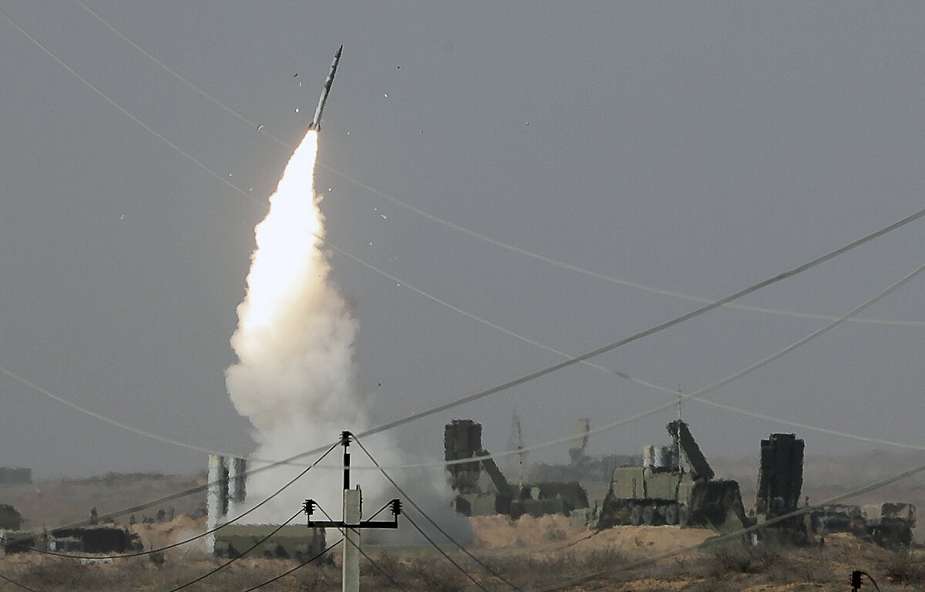- Army
- Conflicts in the world
- Israel - Iran conflict 2025
- Pakistan - India Conflict 2025
- Russia Ukraine War 2022
- Libya conflict day by day
- HAMAS - Israel War 2023
- Operation Serval in Mali French Army
- Sangaris operation Central African Republic
- Sangaris opération militaire République Centreafrique
- Ukraine - Russia conflict
- Syria conflict news
- Defence & Security Industry Technology
- Armies in the world
- Analysis Defense and Security Industry
- Conflicts in the world
- Navy
- Air
Russian MoD Confirms Deployment of Autonomous S-400 Missiles in Ukraine Conflict
According to information released by the Russian Ministry of Defense on November 7, 2023, the Russian army has deployed in Ukraine new S-400 Triumf missiles equipped with active homing heads. These heads contain a radar transceiver, enabling the missiles to autonomously locate and track their targets.
Follow Army Recognition on Google News at this link

Russian army fires in Ukraine S-400 Triumf missiles equipped with active homing heads. (Picture source TASS)
In the ongoing conflict in Ukraine, Russia has strategically combined the use of the S-400 Triumf system with the A-50 early warning and control aircraft to bolster its air defense operations. The S-400 units have been actively engaging enemy aircraft with their missiles, which are designed to autonomously track their targets. Defense Minister Sergey Shoigu reported a significant success on October 25, 2023, stating that the new anti-aircraft missile systems had successfully downed 24 Ukrainian aircraft within a span of five days. The S-400 missiles have been launched over extensive ranges, effectively striking targets at altitudes around 1,000 meters.
The A-50 early warning and control aircraft, known in NATO as the Mainstay, is an airborne early warning and control (AEW&C) platform developed by Russia. Its primary mission is to detect and track airborne and sea surface targets, providing a comprehensive picture of the operational airspace to command centers on the ground, sea, or in the air. This capability significantly enhances the situational awareness and combat effectiveness of Russian military forces.
The A-50 functions as a flying radar station, equipped with a large rotating radar dome above the fuselage. It can track multiple targets simultaneously, including low-flying or ground-level objects, which might be undetectable by ground-based radar systems due to the Earth's curvature or terrain obstacles. The aircraft serves as a command and control hub, capable of directing interceptor fighters towards their targets, managing the battlefield in real-time, and coordinating the actions of multiple units.
Beyond its primary role in surveillance and control, the A-50 also provides guidance for friendly aircraft, extends radar coverage in areas where ground-based radar is unavailable or compromised, and supports air force operations by managing the airspace, enforcing no-fly zones, and directing strike missions. The A-50 can also assist in search and rescue operations, electronic surveillance, and can be used as a command center in case of electronic warfare, providing a resilient communication link in hostile environments.
The S-400 Triumf, also known as the SA-21 Growler by NATO, is an advanced long-range surface-to-air missile (SAM) system developed by Russia's Almaz Central Design Bureau. It is designed to detect, track, and destroy aircraft, drones, and cruise and ballistic missiles in a combat environment. It is considered one of the most capable air defense systems currently in operation. The S-400 employs a variety of radar systems for target acquisition and tracking, and it can engage targets at ranges of up to 400 kilometers and altitudes of up to 30 kilometers. The system is highly mobile and can be deployed within minutes, making it difficult to counteract.
The S-400 system is modular and can use a mix of missiles to create a layered defense against a variety of threats at different ranges and altitudes. It can engage up to 36 targets simultaneously with up to 72 missiles at a time. This versatility, combined with the system's ability to integrate with other air defense systems, makes it a strategic asset for any country's air defense capability. The S-400 has been exported to several countries and has been a point of international interest and concern due to its potential to alter strategic balances in various regions. Its deployment is often seen as a significant enhancement to a nation's air defense capability, contributing to the complexity of modern air warfare and defense strategy.
Active homing heads are a type of guidance system used in modern missiles and torpedoes. These systems are called "active" because they have their own radar or sonar transmitters to send out signals, which then bounce off the target and return to the missile. This allows the missile to track and home in on its target independently, without the need for external guidance after launch. Active homing is particularly useful in situations where the missile must intercept a moving target or when the launch platform cannot maintain a lock on the target, such as in a beyond-visual-range engagement or when the missile must navigate around obstacles.
The advantage of active homing is that it allows the missile to be more resilient against countermeasures and enables it to adjust its flight path in real-time to changes in the target's movement. This makes missiles with active homing heads highly effective against agile targets. The technology involves sophisticated electronics and signal processing to distinguish the target from other objects or decoys. As technology advances, active homing heads are becoming more compact, more reliable, and more capable of engaging targets at longer ranges and with higher accuracy.
News Russia Ukraine War


























